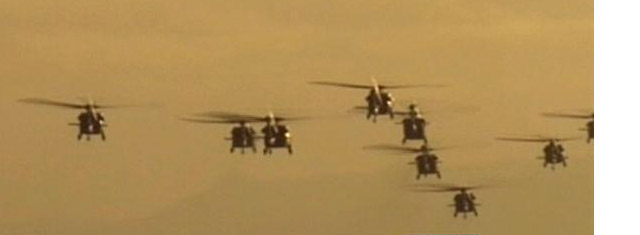Uncommon yard bird: Blackhawk fly-over
The other morning around 6 am I was awakened by a neighbor: the Army National Guard’s Papago Military Station thumped deafeningly with the rotors of helicopters. I went out to look: the National Guard is usually a quiet neighbor, with only occasional popping of target practice audible from our street. The airstrip no longer hosts fixed-wing craft, so apart from infrequent “chopper” traffic, we’re not often disturbed by activities on the Reservation.
But this morning, the din was hard to ignore so I went out front to watch. The houses across the street are slightly up hill from ours, so my view was over their rooves, and at first I couldn’t see anything but a rolling cloud of brown dust like a haboob, kicked up as the ‘copters waited on the old landing strip.
For more than three quarters of an hour, the rotors thumped. From the enormous noise they were making, I guessed there was more than one, maybe three or four. At 7 am, they lifted off — TEN Blackhawk helicopters, one at a time, to the east, headed to Fort Sill Oklahoma to join the 2-285th Aviation Assault Battalion, eventually bound for Iraq. Ten! — no wonder the sound of their blades shook the ground, throbbed in my ribs.
Whatever your feelings about Instruments of War, ten powerful Blackhawk helicopters heavily rising one by one into the dawnzerly light make an impressive scene, the roar of the blades changing with the stress of becoming airborne. There was something surreal about it, somehow outside Nature, when measured by my usual yardstick of even the largest flying creatures we’re accustomed to in the desert neighborhood: Common ravens, Great horned owls, and Turkey vultures. These giant copters were like winged prehistoric creatures that ought to be too massive to fly: Pterodactyls are our neighbors.
